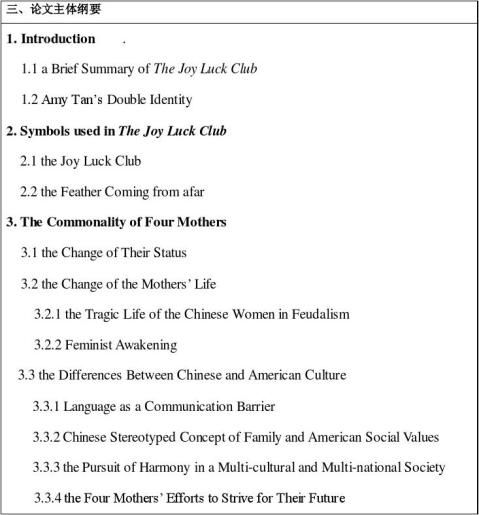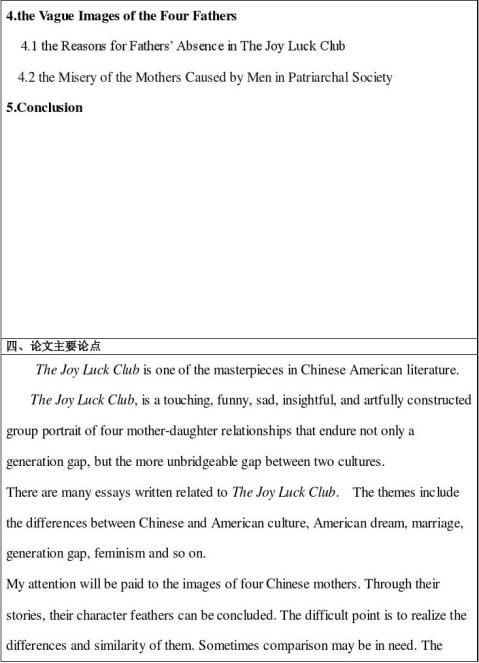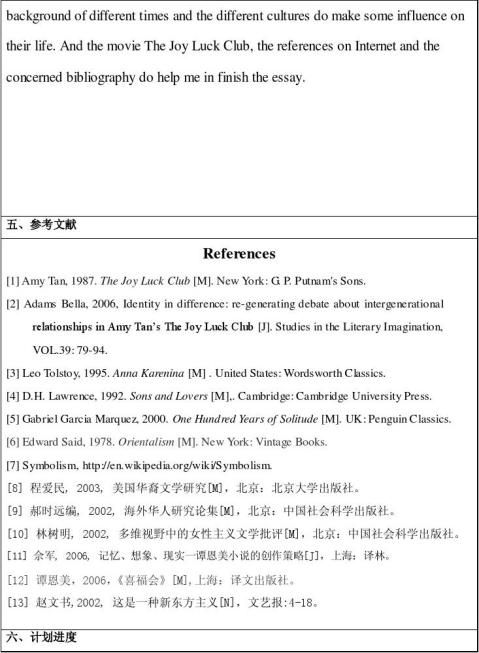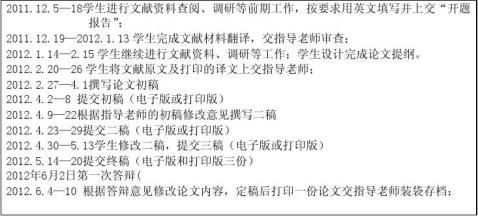(An analysis of the image of Chinese mothers in The Joy Luck Club 喜福会中华裔母亲形象研究)开题报告2
大家懂的 这个论文我自己写的
一共分成了四个部分
开题报告分为两部分
配套的文献翻译分为4个部分
都可以在我上传的文档里下载




第二篇:(An analysis of the image of Chinese mothers in The Joy Luck Club 喜福会中华裔母亲形象研究)文献翻译2
大家懂的 这个论文我自己写的
一共分成了四个部分
这个是配套的文献翻译分为4个部分
开题报告也可以在我上传的文档里下载
between mother and daughter is noted by An-mei in particular, a resemblance that she extends to all Chinese and Chinese American women: "All of us are like stairs, one step after another, going up and down, but all going the same way". Furthermore, the narrators suggest, albeit negatively, the benefits of intergenerational identification as a way of averting the "irritation... upset and silence" engendered particularly when the daughters defy material expectations with their "new thoughts, willful thoughts. or rather thoughts filled with lots of won'ts". This direct/indirect opposition is vividly reconfigured as skin/bone or surface/depth in An-mei's story, "Scar": "My mother took her flesh and put it in the soup. She cooked magic in the ancient tradition to try to cure her mother this one last time". Although literally failing to enliven,
cannibalism conveys the idea that a mother's identity depends on that of her daughters', to the point that fleshly differences seem inconsequential. Without skin, the two generations of women are rendered identical: "Your mother is in your bones!", and, as Jing-mei later proclaims, "in our blood" . A proclamation of this kind leads TuSmith to conclude "that underneath the skin, we mother/daughter, Chinese/American, etc are all one". This "oneness" is apparently borne out at the end of The joy Luck Club when Jing-mei finally meets her Chinese sisters. Their meeting is captured on camera, the Polaroid photograph apparently reflecting a unity not only between siblings but also between them and their Chinese mother: "Together we look like our mother". "This composite image," remarks TuSmith, "reflects the novel's communal subtext, which works as a counterpoint to the textual surface of individualistic strife".
Moreover, why would Jing-mei want to pass for Suyuan given that she is dead? Perhaps Jing-mei's references to things such as cities, pictures, and calendars also convey the idea that to replace Suyuan involves a deadening objectification. From this
perspective, then, intergenerational identification celebrated by so many of Tan's mainstream critics is also harmful because it obliterates identity, objectifying and essentializing women to such an extent that they become things, if not, as Tan puts it in The Opposite of Fate, "those little dolls sold in Chinatown tourist shops, heads bobbing up and down in complacent agreement to anything said!". With such an "agreeable" figure dominating American culture, not just now, but at least since the 1830s and the arrival of the first "Doll" from China, it is hardly surprising that
narrators in The Joy Luck Club utilize a violent rhetoric of fighting tigers and women armed with kitchen utensils as a way of reversing this stereotype. Yet, the representation of stereotypes, even when they are reversed, proves risky, most obviously when Tan is charged with neo-conservatism, neo-Orientalism, and
neoracism for these and the other stereotypes that are so common in The Joy Luck Club: from Waverly's, "he is gay.... He could have AIDS", and Rose's, "I was victim to his white hero", to An-mei's assumption that M&Ms and sweatshirts "would make her brother very rich and happy by communist standards", never mind the
Orientalist/Occidentalist stereotyping as performed by both generations. All of Tan's narrators are at one point or another represented as having "closed ... minds", making them "co-conspirators ... turned traitors".
Clearly, then, Chinese and Chinese American women in The Joy Luck Club are not beyond prejudice, rendering Tan a functionary of dominant ideologies in the opinion of her more critical commentators on both sides of the masculinist/feminist divide. But to represent Chinese mothers and American-born daughters as necessarily epistemologically advantaged or, as Wong puts it about the Chinese motherland, "a locus of truth", is to leave their suspect ideological remarks unchallenged ultimately in keeping with the ideological notion of "The Native as ... the Non-Duped". Whether Chinese and Chinese American women, are duped or non-duped, China dolls or fighting tigers, they are caught in a double bind in part constituted by an
inside/outside model of ideology, not just dominant ideologies. The fact that Tan's narrators can neither escape nor deny ideology, a fact that The joy Luck Club resists "sweetening," even if it risks the charge of neo-conservatism, neo-Orientalism, and
neo-racism, does not have to be interpreted negatively. Granted, the persistence of various essences and stereotypes denies the narrators their and the novel's
"happily-ever-after" ending, although, at the same time, the resistance to such an ending ensures a future for debate in and around The joy Luck Club. The general movement of the narrative and the relationships therein, from "malignancy" to a situation whereby Chinese mothers are seen teaching their American born-daughters about how to "multiply their peachblossom luck'' and "How to laugh forever", would seem to confirm the possibility of debate for six of the narrators. Indeed, the fact means that they can potentially participate in symmetrical, even ethical
intergenerational/intercultural relationships consistent with "joy luck" and its
openness not only to the future but also to the other. Not surprisingly, this openness depends on each narrator acknowledging her "closed mind" and subsequent tendency for misrepresentation, which all six do, more or less, typically via
intergenerational/intercultural debate. As the dominant narrator, in so far as she
narrates in all four parts of the novel, thereby crossing the generational/cultural lines, Jing-mei is in a position of power over others—her mother and her sisters. This power effectively prevents her forming ethical relationships, were it not for the fact that she repeatedly draws attention to her own ontological, epistemological, and, ultimately, ideological limitations arguably in the context of a wider debate about the ethics of representing that which is mother compatible with "identity-in-difference." More precisely, the fact that Jing-mei cannot be and cannot know Suyuan because of the difference between them, reinforced by the life/ death opposition, allows her to address arguably more radically than the other narrators the implications of representation with regard to both self/other. Granted, representation involves a deadening objectification, if not of herself, then of her mother, but Jing-mei has to speak for Suyuan, reducing both their identities in this essentially political process to "the representative" and "the constituent" respectively.
Not "merely" a formal interruption to this almost symmetrical novel that almost ends "happily ever after," the Woos relationship also interrupts an ideological understanding of literariness based on its presumed capacity to reconcile reliably different entities—from Chinese mothers and American-born daughters to novel and
meaning/referent. This capacity for reconciliation and other terms to do with closure are at issue in The Joy Luck Club, particularly when Jing-mei tries unsuccessfully to represent Suyuan. Crucially, however, Jing-mei's "failure" proves her and by extension the novel's "success" in that it highlights how an essence, which, in this case, "is" Suyuan, is deconstructed linguistically and ideologically in a way that opens up the debate about essentialism in and around The joy Luck Club. Perhaps more so than the other "women" since she, unlike them, is "dead" and so is unable to participate in intergenerational/intercultural debate, Suyuan is most vulnerable to essentialism because Jing-mei speaks for her Vertretung. At the same time, however, her "death" also functions to draw attention to the fact that she is and, indeed, has to be an effect—a literary effect as are the other "women". And, no amount of essentializing and ideologizing on the part of Jing-mei and, for that matter, some of Tan's readers, even if done for sentimental reasons, can alter this fact. As a literary effect, not a woman subject to life, death, and resurrection, Suyuan is at once identical and non-identical to her daughter's representation in the sense that her identity in the novel is dependent on the power of representation to overcome the difference that sustains it. This overcoming is only possible in ideology, and then not absolutely since it privileges identity, if not "identitarianism," over difference and, by extension, political representation over aesthetic representation ultimately made impossible by the "identity-in-difference" relationship between them. Jing-mei is understandably upset by the fact that she cannot overcome the difference of Suyuan's "death" and, for that matter, "life," especially when her mother, she recalls, "always said things that didn't make any sense, that sounded both good and bad at the same time". In other words. it is upsetting for Jing-mei not to know her mother's meaning. Suyuan's gift of "life's importance," a jade pendant, proves similarly confusing to Jing-mei: "What if ... this curving line branching into three oval shapes is a pomegranate tree and that my mother was ... wishing me fertility and posterity? What if my mother really meant the carvings were a branch of pears to give me purity and honesty? Or ten-thousand-year droplets from the magic mountain, giving me my life's direction and a thousand years of fame and immortality?". Crucially, Jing-mei's questions go unanswered, even though she wears the pendant close to her skin like Suyuan wore it close to hers, this closeness obviously not being close enough to finalize the meaning of either the pendant or the mother. Although upsetting, Jing-mei's inability to identify with Suyuan's meaning does nevertheless provide the basis for an ethical relationship between mother/daughter, self/other and, ultimately, novel/reader. Understood in this
-
英语专业20xx届毕业论文开题报告
曲靖师范学院本科毕业论文设计开题报告论文题目AmericanCultures作者施莎莎学号20xx031381院系外国语学院年级2…
-
喜福会开题报告
运城学院本科生毕业论文开题报告论文题目:从《喜福会》中的母女冲突看中美教育文化的差异OntheDifferencesbetween…
-
开题报告 从文化的角度分析《喜福会》中所反映的中西方家庭教育的差异
XXXXXX学院本科毕业论文设计开题报告题目从文化的角度分析喜福会中的中西方家庭教育的差异姓名XXX学号XXXXXXXXXX专业年…
- (An analysis of the image of Chinese mothers in The Joy Luck Club 喜福会中华裔母亲形象研究)开题报告1